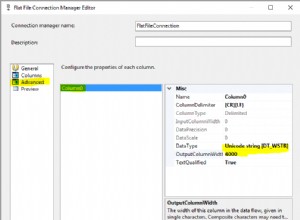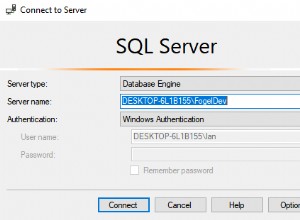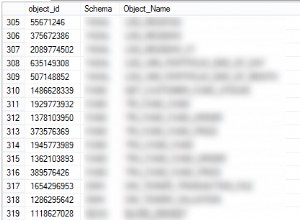chỉ khi bạn có ít hơn 10000 email .... điều đó có thể chấp nhận được không?
select
if(t1.c > 1, concat(e.employeename, ' (', e.employeeid, ')'), e.employeename) as Employee,
replace(substring(substring_index(e.EmailAddresses, ',', n.row), length(substring_index(e.EmailAddresses, ',', n.row - 1)) + 1), ',', '') EmailAddress
from
(select employeename, count(*) as c from Employees group by employeename) as t1,
(select EmployeeID, length(EmailAddresses) - length(replace(EmailAddresses,',','')) + 1 as emails from Employees) as t2,
(SELECT @row := @row + 1 as row FROM
(select 0 union all select 1 union all select 3 union all select 4 union all select 5 union all select 6 union all select 6 union all select 7 union all select 8 union all select 9) x,
(select 0 union all select 1 union all select 3 union all select 4 union all select 5 union all select 6 union all select 6 union all select 7 union all select 8 union all select 9) x2,
(select 0 union all select 1 union all select 3 union all select 4 union all select 5 union all select 6 union all select 6 union all select 7 union all select 8 union all select 9) x3,
(select 0 union all select 1 union all select 3 union all select 4 union all select 5 union all select 6 union all select 6 union all select 7 union all select 8 union all select 9) x4,
(SELECT @row:=0) as ff) as n,
Employees e
where
e.employeename = t1.employeename and
e.employeeid = t2.employeeid and
n.row <= t2.emails
order by e.employeeid;
CHỈNH SỬA:
Với số lượng ít vô ích hơn được tạo ra:
select
if(t1.c > 1, concat(e.EmployeeName, ' (', e.EmployeeID, ')'), e.EmployeeName) as Employee,
replace(substring(substring_index(e.EmailAddresses, ',', n.row), length(substring_index(e.EmailAddresses, ',', n.row - 1)) + 1), ',', '') as EmailAddress
from
(select EmployeeName, count(*) as c from Employees group by EmployeeName) as t1,
(select EmployeeID, length(EmailAddresses) - length(replace(EmailAddresses,',','')) + 1 as emails from Employees) as t2,
(select `1` as row from (select 1 union all select 2 union all select 3 union all select 4) x) as n,
Employees e
where
e.EmployeeName = t1.EmployeeName and
e.EmployeeID = t2.EmployeeID and
n.row <= t2.emails
order by e.EmployeeID;
Và chúng ta đã học được gì? Thiết kế cơ sở dữ liệu kém dẫn đến các truy vấn khủng khiếp. Và bạn có thể làm mọi thứ với SQL, có thể chỉ được hỗ trợ vì mọi người thiết kế cơ sở dữ liệu kém ... :)




